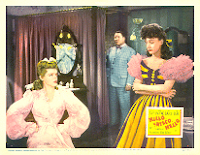 It's back to the department store for Loretta Young and Winnie Lightner, stars of last night's movie, PLAY-GIRL (1932). Tonight Loretta and Winnie play girls in a department store steno pool who are asked to entertain out-of-town buyers in SHE HAD TO SAY YES.
It's back to the department store for Loretta Young and Winnie Lightner, stars of last night's movie, PLAY-GIRL (1932). Tonight Loretta and Winnie play girls in a department store steno pool who are asked to entertain out-of-town buyers in SHE HAD TO SAY YES.SHE HAD TO SAY YES was extremely entertaining, although it will make the women in the audience want to smack every man in the cast, and the jaw-dropping last five minutes will leave viewers with a severe case of mental whiplash. Indeed, the film's outrageous finale is part of its strange, bizarre charm. The modern viewer can't quite believe the script is for real, with lovely Loretta treated like dirt by two different men, yet happily going off into the sunset with one of them. (Well, not quite the sunset. The final shot left me gaping at the screen in stunned amazement.)
Pretty Florence (Young) is secretary to her fiance, department store executive Tommy Nelson (Regis Toomey). Tommy doesn't want his fiancee drafted into dating and "being nice" to aggressive out-of-town buyers, but then changes his mind when he decides he wants to two-time Florence and go out with Birdie (Suzanne Kilborn). Buyer Danny Drew (Lyle Talbot) puts the heavy moves on Florence, but then realizes she's really a nice girl and sends her home.
Florence catches Tommy with Birdie and breaks their engagement; meanwhile Florence is hotly pursued by Danny. Then Danny decides Florence could help him land a merger deal with Luther Haines (Hugh Herbert)...however, when Florence is successful, Danny becomes angry with her because he thinks maybe she's not really a nice girl after all. Got all that?! Before you know it, Danny and Tommy are duking it out over whether or not Florence is a tramp... All this in a mere 65 minutes.
This is Depression-era pre-Code soap of the highest order, with attitudes toward women so cavalier and alien that it really has to be seen to be believed. As a reviewer wrote at IMDb, "The final lines of dialogue will leave your head spinning...it will blow you away." Another reviewer said, "Having seen lots of pre-Code films over the years, I have to say this was the first time I held my hand over my mouth and gasped."
I thought Loretta's EMPLOYEES' ENTRANCE, another department store melodrama from 1933, was disturbing, but this was on another level entirely...although ironically, I liked SHE HAD TO SAY YES a lot better than EMPLOYEES' ENTRANCE. I thought it had better pacing and wasn't as depressing.
Although the overall plotline of SHE HAD TO SAY YES is from Mars, the script has some very good one-liners, a couple of which are given to Lightner, once again playing Loretta Young's best friend.
Loretta gives another of her excellent early '30s portrayals of a working woman struggling to get by and hoping for a loving marriage with a decent man. Poor Loretta's Depression heroines had the worst luck at times finding a man who was true blue and not a jerk. (James Cagney, who played Loretta's husband in the terrific 1932 film TAXI!, is another example of her characters' questionable taste in men.) Talbot is also particularly good as Danny, who is by turns charming, romantic...and downright scary.
Busy bit players Charles Lane and George Chandler, who were both in TWENTY MILLION SWEETHEARTS (1934), reviewed here last weekend, turn up again in this. Lane is a department store executive and Chandler is a taxi driver.
The cast also includes Ferdinand Gottschalk, Helen Ware, and Toby Wing.
This film was codirected by Busby Berkeley and George Amy. This was Berkeley's first directing credit.
SHE HAD TO SAY YES can be seen on Turner Classic Movies. It does not appear to have had a DVD or VHS release.
Like PLAY-GIRL, the movie has a somewhat racy trailer, although this one at least is more relevant to the movie's actual plot.









































